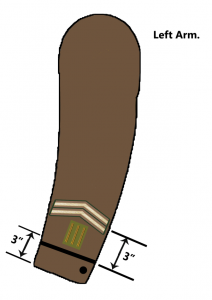WOUND STRIPE
Information from The Long, Long Trail
First authorised
The stripe was first authorised under Army Order 204 of 6 July 1916:
“The following distinctions in dress will be worn on the service dress jacket by all officers and soldiers who have been wounded in any of the campaigns since 4th August, 1914:-
Strips of gold Russia braid, No.1, two inches in length, sewn perpendicularly on the left sleeve of the jacket to mark each occasion on which wounded. In the case of officers, the lower end of the first strip of gold braid will be immediately above the upper point of the flap on cuff. Warrant officers, non-commissioned officers and men will wear the gold braid on the left sleeve, the lower edge of the braid to be three inches from the bottom of the sleeve. The additional strips of gold braid, marking each subsequent occasion on which wounded, will be placed on either side of the original one at half-inch interval. Gold braid and sewings will be obtained free on indent from the Army Ordnance Department; the sewing on will be carried out regimentally without expense to the public.”
But how did a man qualify?
The Army Order was followed by Army Council Instruction No. 1637 of 22 August 1916 …
“…. it is notified for information, that the term ‘wounded’ refers only to those officers and soldiers whose names have appeared, or may hereafter appear, in the Casualty Lists as ‘wounded’. The braid will be supplied to officers and soldiers under regimental arrangements, and Commanding Officers will ensure that it is not worn by those who are not entitled to it. Sufficient for two jackets will be supplied to each man.”
… and was refined by Army Council Instruction No. 2075 of 3 November 1916:
“1. The term ‘wounded’ refers only to those officers and soldiers whose names have appeared or may hereafter appear in casualty lists rendered by the Adjutant General’s office at a base overseas, or by the G.O.C. any force engaged in active operations. Reports in hospital lists are not to be regarded as authoritative for this purpose.
2. Officers and men reported ‘wounded – gas,’ or ‘Wounded – shock, shell,’ are entitled to the distinction.
Accidental or self-inflicted wounds or injuries do not qualify.”

